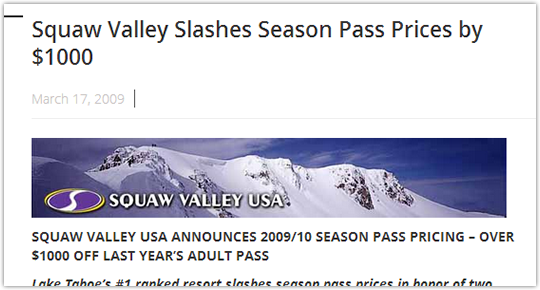Season Passes (All)
Are Season Passholders Being Treated Like the Proverbial Frog and Boiling Pot of Water?


BLANCHARD
Let me first preface this post with a disclaimer of my much-lower-than-I-want-it-to-be understanding of pricing strategy, but I want to quickly share a trend and then, at the end, discuss the implications. And, most importantly, if it works.
Now, the closest thing this trend may resemble is a frog in a boiling pot of water, but the frogs are skiers and the pots of water are pass prices.
STEP 1: The “Slash”
Season pass prices can get high, very high, in some regions void of stiff, nearby competition.
In effect, these pass prices are like pots of boiling water. Try to toss a non-passholder in and they’ll quick jump out. They can’t handle that kind of price.
But, what we often see in the ski industry is something typically referred to as a “Slash” where the cauldron is brought down to a milder temperature (price).
Examples
This year we saw it at Nakiska (was $800):
That's right we did! "Nakiska ski resort slashes price of season’s pass to $199, down from more than $800"… http://t.co/i8344sVI73
— Nakiska Ski Area (@SkiNakiska) May 29, 2014
Last year it was Snowshoe (was $579):
The Ridiculous Pass is here! $199 for an unlimited season pass valid for next season AND the rest of this season. http://t.co/kvcZI1aw
— Snowshoe Mountain (@snowshoemtn) February 19, 2013
And five years ago it was Squaw:
Going against the typical skiing/price narrative, these slashes grab headlines and generate loads of new passholders.
STEP 2: The Rise
Before long, however, the temperature beings to rise. Cold water isn’t permanent in the frog scenario and neither are rock-bottom prices in the pass arena.
However, the theory seems to be the same. If I can raise the temperature (price) slowly enough, maybe frogs (skiers) will adapt and stick with it rather than bail.
Examples
This year Snowshoe brought the Ridiculous pass back at the same $199, but the regular rate jumped from $299 last year…
Squaw’s Bronze pass has shown the smallest change, but while the price is nearly identical to what it was in 2009, that pass is restricted by about 30% more blackout days than the original.
STEP 3: Back to Boiling
I think the big question that remains is what happens when prices return to boiling. We’ve seen a hadnful of slashes through the years, but each seems to be on a trajectory to their original state.
The Epic Pass is one example.
Before “pass wars”, a Vail season pass was well over $1,000. But in 2007 the Colorado Pass Plus started at $549 and included unlimited access to all of Vail’s Colorado Mountains. When the Epic Pass launched the next year, it debuted at $579.
When I arrived in Coloraod in 2011, passes were $649. Today, an EpicPass runs $729 early season. With a hat tip to inflation, that $549 pricepoint of 2007 would run about $627 today.
Does it Work
Here’s my corcern. Once you slash prices, it seems to paint your pass strategy into a corner.
If you keep prices as is, you’ll lose the PR value of the “new” price after a few years and suddenly the discount becomes the norm.
If you slowly raise like some resorts are doing, you’ll lose the PR value (and new passholders) quicker and soon find yourself in a season pass no-man’s-land where you’ve lost the new passholders but are selling a similar volume as before but at a huge discount compared to the original.
It’s a risky campaign and not one I’m too keen on. In the short term, PR and passholders go up, But the long term, well, that’s where I’m starting to scratch my head.
About Gregg & SlopeFillers
I've had more first-time visitors lately, so adding a quick "about" section. I started SlopeFillers in 2010
with the simple goal of sharing great resort marketing strategies. Today I run marketing for resort ecommerce and CRM provider
Inntopia,
my home mountain is the lovely Nordic Valley,
and my favorite marketing campaign remains the Ski Utah TV show that sold me on skiing as a kid in the 90s.
Get the weekly digest.
New stories, ideas, and jobs delivered to your inbox every Friday morning.



